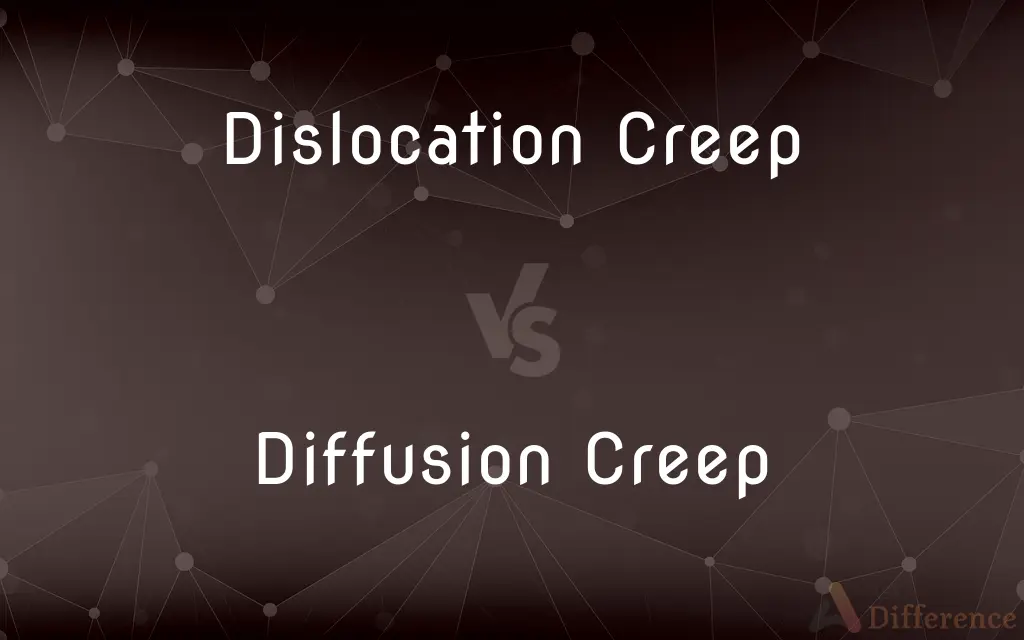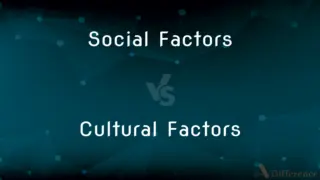Dislocation Creep vs. Diffusion Creep — What's the Difference?
By Tayyaba Rehman — Published on November 22, 2023
Dislocation Creep involves the movement of dislocations through a material's crystal lattice, while Diffusion Creep is the movement of atoms in response to stress, generally via vacancies or grain boundaries.

Difference Between Dislocation Creep and Diffusion Creep
Table of Contents
ADVERTISEMENT
Key Differences
Dislocation Creep is a deformation mechanism that occurs when a material is subjected to stress. In this process, dislocations, which are linear defects within the crystal lattice of a material, move through the lattice. This movement facilitates plastic deformation of the material under stress. On the contrary, Diffusion Creep involves the movement of atoms within the material. Instead of dislocations sliding or moving through the lattice, atoms themselves migrate from areas of high stress to areas of low stress.
Dislocation Creep typically becomes significant at higher stresses and is more common in materials with a larger grain size. The movement of dislocations results in a permanent change in the material's shape without breaking the atomic bonds. In comparison, Diffusion Creep is dominant at lower stresses and often in materials with finer grain sizes. Here, atomic movement or diffusion can occur through the lattice (lattice diffusion) or along grain boundaries (grain boundary diffusion).
In Dislocation Creep, the primary driving force is the applied stress that causes the dislocations to move. This movement can be envisioned as a ripple moving through a carpet, creating a wave-like deformation. In the realm of Diffusion Creep, the driving force is the differential in atomic concentration caused by the applied stress, leading atoms to migrate and redistribute.
To summarize, while both Dislocation Creep and Diffusion Creep are mechanisms by which materials deform under stress, their methods of action differ significantly. Dislocation Creep involves the movement and interaction of dislocations in a material's lattice, while Diffusion Creep is centered on the atomic diffusion due to stress concentration differences.
Comparison Chart
Mechanism
Movement of dislocations
Movement of atoms
ADVERTISEMENT
Dominant in
Higher stresses, larger grain sizes
Lower stresses, finer grain sizes
Movement Type
Through crystal lattice
Via vacancies or grain boundaries
Driving Force
Applied stress
Differential in atomic concentration
Resultant Deformation
Plastic deformation
Redistribution of atoms
Compare with Definitions
Dislocation Creep
Dislocation Creep causes plastic deformation in materials.
Under constant load, the metal exhibited Dislocation Creep.
Diffusion Creep
Diffusion Creep results from atomic migration in a material.
Under microscopic examination, the Diffusion Creep was evident.
Dislocation Creep
Dislocation Creep operates significantly at higher stresses.
As the applied stress increased, Dislocation Creep became dominant.
Diffusion Creep
Diffusion Creep can involve lattice or grain boundary diffusion.
In this polycrystalline sample, Diffusion Creep occurred mainly along grain boundaries.
Dislocation Creep
Dislocation Creep's rate can be influenced by temperature.
Raising the temperature accelerated the rate of Dislocation Creep.
Diffusion Creep
Diffusion Creep is dominant in fine-grained materials.
Nanomaterials typically exhibit Diffusion Creep under mild stresses.
Dislocation Creep
Dislocation Creep is deformation through dislocation movement.
Metals often deform via Dislocation Creep under high stress.
Diffusion Creep
Diffusion Creep relies on concentration differences induced by stress.
The atoms moved via Diffusion Creep to balance concentration disparities.
Dislocation Creep
Dislocation Creep results from linear defects moving in a lattice.
Observing Dislocation Creep gives insights into material strength.
Diffusion Creep
Diffusion Creep involves atoms moving due to stress.
Ceramics often show Diffusion Creep at elevated temperatures.
Common Curiosities
What is Dislocation Creep?
Deformation due to the movement of dislocations through a material's crystal lattice.
How do temperature and stress influence Dislocation Creep?
They can accelerate the rate of Dislocation Creep, making it more prominent.
When is Dislocation Creep dominant?
Typically at higher stresses and in materials with larger grain sizes.
How does Diffusion Creep work?
By the movement of atoms in response to stress, generally via vacancies or grain boundaries.
Does Diffusion Creep involve atomic or dislocation movement?
It involves atomic movement, not dislocations.
Why is understanding Dislocation Creep important?
It helps in predicting and enhancing material performance under stress.
What's the visual difference between Dislocation Creep and Diffusion Creep?
Dislocation Creep shows sliding or movement of planes, while Diffusion Creep displays more uniform atomic redistribution.
Why is Diffusion Creep common in nanomaterials?
Due to their fine grain sizes and increased grain boundary areas.
What materials commonly show Diffusion Creep?
Often fine-grained materials, especially at lower stresses.
In what conditions does Diffusion Creep become significant?
At lower stresses and elevated temperatures, especially in fine-grained materials.
Can a material exhibit both Dislocation Creep and Diffusion Creep?
Yes, depending on the conditions like stress, temperature, and grain size.
How does grain size affect Dislocation Creep?
Larger grain sizes typically enhance the prominence of Dislocation Creep.
How can we reduce the effects of Dislocation Creep in materials?
By alloying, refining grain sizes, or modifying processing conditions.
How do dislocations in Dislocation Creep move?
They move through the crystal lattice of a material, facilitating deformation.
Is Diffusion Creep restricted to grain boundaries?
No, it can occur through lattice diffusion as well.
Share Your Discovery

Previous Comparison
Maruti Suzuki 800 vs. Maruti Suzuki Alto 800
Next Comparison
Social Factors vs. Cultural FactorsAuthor Spotlight
Written by
Tayyaba RehmanTayyaba Rehman is a distinguished writer, currently serving as a primary contributor to askdifference.com. As a researcher in semantics and etymology, Tayyaba's passion for the complexity of languages and their distinctions has found a perfect home on the platform. Tayyaba delves into the intricacies of language, distinguishing between commonly confused words and phrases, thereby providing clarity for readers worldwide.













































